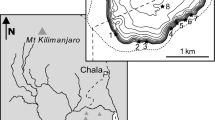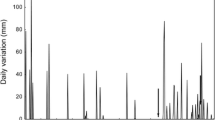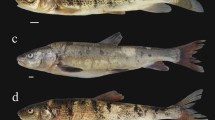Abstract
Feeding preferences in two tropical omnivorous fishes, Oreochromis shiranus and Barbus paludinosus were similar when offered an array of planktonic food in aquaria. The two species were stocked into earthen ponds at different rates. Abiotic and biotic variables were measured over a period of 120 days. Data analysis by multiple linear regression did not reveal significant negative coefficients between adjacent trophic levels, which would have indicated top-down effects. It is suggested that the results are due to uncoupling between trophic levels in tropical freshwater ecosystems.
Similar content being viewed by others
References
Brummett, R. E. & K. Katambalika, 1996. Protocols for the development of indigenous species: polyculture of indigenous species under Malawian smallholder conditions. Aquacul. Res. 27: 225–233.
Carpenter, G. F., 1974. A proposed method suitable for large-scale surveys of biomass in lakes. J. Fish. Res. Bd Can. 31: 327–328.
Carpenter, S. R., J. F. Kitchell & J. R. Hodgson, 1985. Cascading trophic interactions and lake productivity: Fish predation and herbivory can regulate lake ecosystems. BioScience 35: 634–639.
Chesson, J., 1978. Measuring preference in selective predation. Ecology 59: 211–215.
Diana, J. S., D. J. Dettweiler & C. K. Lin, 1991. Effect of nile tilapia (Oreochromis niloticus) on the ecosystem of aquaculture ponds, and its significance to the trophic cascade hypothesis. Can. J. Fish. aquat. Sci. 48: 183–190.
Drenner, R. W. & S.R. McComas, 1980. The role of zooplankter escape ability and fish size selectivity in the selective feeding and impact of planktivorous fish. In W. C. Kerfoot (ed.), Evolution and Ecology of Zooplankton Communities. The University Press of New England, Hanover (N.H.): 587–593.
Drenner, R. W., J. R. Strickler & W. J. O'Brien, 1978. Capture probability: The role of zooplankter escape in the selective feeding of planktivorous fish. J. Fish. Res. Bd Can. 35: 1370–1373.
Drenner, R. W., G. L. Vinyard, M. Gophen & S. R. McComas, 1982. Feeding behaviour of the cichlid, Sarotherodon galilaeum: selective predation on Lake Kinneret zooplankton. Hydrobiologia 87: 17–20.
Dumont, H. J., I. Van de Velde & S. Dumont, 1975. The dry weight estimate of biomass in a selection of cladocera, copepoda and rotifera from the plankton, periphyton and benthos of continental waters. Oecologia 19: 75–97.
Durbin, J. & G. S. Watson, 1951. Testing for serial correlation in least squares regression. II. Biometrica 38: 159–178.
Edmondson, W. T, 1974. A simplified method for counting phytoplankton. In R. A. Vollenweider (ed.), A Manual on Methods for Measuring Primary Production in Aquatic Environments. IBP Handbook no. 12. Blackwell Scientific Publications, Oxford: 14–16.
Fernando, C. H., 1994. Zooplankton, fish and fisheries in tropical fresh waters. Hydrobiologia 272: 105–123.
Furse, M. T., R. G. Kirk, P. R. Morgan & D. Tweddle, 1979. Fishes: distribution and biology in relation to changes. In M. Kalk, A. J. MacLachlan & C. Howard-Williams (eds), Lake Chilwa: Studies of Change in a Tropical Ecosystem. Monographiae Biologicae 35. Dr W. Junk Publishers, The Hague: 175–208.
Gaigher, I. G., 1973. The habitat preferences of fishes from the Limpopo river system, Transvaal and Mocambique. Koedoe 16: 103–116.
Greenwood, P. H., 1953. Feeding mechanisms of the cichlid fish Tilapia esculenta Graham. Nature 172: 207–208.
Hopkins, K.D., M.L. Hopkins & D. Pauly, 1988. A multivariate model of tilapia growth, applied to seawater tilapia culture in Kuwait. In R. S. V. Pullin, T. Bhukaswan, K. Tonguthai & J. L. Maclean (eds), The Second International Symposium on Tilapia in Aquaculture. ICLARM Conference Proceedings 15. International Center for Living Aquatic Resources Management, Manila: 29–39.
Kerfoot, W. C., 1987. Cascading effects and indirect pathways. In W. C. Kerfoot & A. Sih (eds), Predation — Direct and Indirect Impacts on Aquatic Communities. University Press of New England, Hanover and London: 57–70.
Krebs, C. J., 1989. Ecological Methodology. Harper Collins, New York, 654 pp.
Lazzaro, X., 1987. A review of planktivorous fishes, their evolution, feeding behaviours, selectivities and impacts. Hydrobiologia 146: 97–167.
Lowe-McConnell, R. H., 1982. Tilapias in fish communities. In R. S. V. Pullin & R. H. Lowe-McConnell (eds), The Biology and Culture of Tilapias. ICLARM Conference Proceedings 7 International Center for Living Aquatic Resources Management, Manila: 83–113.
Lowe-McConnell, R. H., 1987. Ecological Studies in Tropical Fish Communities. Cambridge University Press, Cambridge, 382 pp.
Manly, B.J.F, P. Miller, L.M. Cook, 1972. Analysis of a selective predation experiment. Am. Nat. 106: 719–736.
Marshall B. & M. Maes, 1994. Small water bodies and their fisheries in southern Africa. CIFA Tech. Pap. 29. FAO, Rome.
Mattson, N. S., 1994. Direct estimates of multi-mesh gillnet selectivity to Oreochromis shiranus chilwae. J. Fish Biol. 45: 997–1012.
Mattson, N. S., 1997. Fish production and ecology in African small water bodies, with emphasis on tilapia. Ph.D. Thesis, Stockholm University, Stockholm.
Mattson, N. S. & E. K. W. H. Kaunda, 1997. Population dynamics of Oreochromis shiranus in two small water bodies in Malawi. J. Fish Biol. 50: 592–607.
Mattson, N. S. & J. C. Mutale, 1992. Multi-mesh gillnets to estimate species composition and catch per unit effort of fish in a small water body in Zambia. J. Fish Biol. 41: 897–908.
McCauley, E., 1984. The estimation of the abundance and biomass of zooplankton in samples. In J. A. Downing & F. H. Rigler (eds), A Manual on Methods for the Assessment of Secondary Productivity in Fresh Waters. IBP Handbook No.17, 2nd edition. Blackwell Scientific Publications, Oxford: 228–265.
Noakes, D. G. L & E. K. Balon, 1982. Life histories of tilapias: An evolutionary perspective. In R. S. V. Pullin & R. H. Lowe-McConnell (eds), The Biology and Culture of Tilapias. ICLARM Conference Proceedings 7. International Center for Living Aquatic Resources Management, Manila: 61–82.
Northcott, M. E. & M. C. M. Beveridge, 1988. The development and structure of the pharyngeal apparatus associated with filter feeding in tilapias. J. Zool., Lond. 215: 133–149.
O'Brien, W. J., 1987. Planktivory by freshwater fish: Thrust and Parry in the pelagia. In W. C. Kerfoot & A. Sih (eds), Predation — Direct and Indirect Impacts on Aquatic Communities. University Press of New England, Hanover and London: 3–16.
Prein, M., G. Hulata & D. Pauly, 1993. Multivariate methods in aquaculture research: case studies of tilapias in experimental and commercial systems. ICLARM Stud. Rev. 20. International Center for Living Aquatic Resources Management, Manila, 221 pp.
Robotham, P. W. J., 1990. Trophic niche overlap of the fry and juveniles of Oreochromis leucostictus (Teleostei, Cichlidae) in the littoral zone of a tropical lake (L. Naivasha, Kenya). Rev. Hydrobiol. trop. 23: 209–218.
Skelton, P., 1993. A complete guide to the freshwater fishes of southern Africa. Southern Book Publishers (Pty), Halfway House, 388 pp.
Sparre, P. & S. C. Venema, 1992. Introduction to tropical fish stock assessment. Part 1. Manual. FAO Fish. Tech. Pap. No. 306.1, Rev. 1. FAO, Rome.
Vinyard, G. L., R. W. Drenner, M. Gophen, U. Pollingher, D. L. Winkelman & Hambright, K. D., 1988. An experimental study of the plankton community impacts of two omnivorous filterfeeding cichlids, Tilapia galilaea and Tilapia aurea. Can. J. Fish. aquat. Sci. 45: 685–690.
Watson, N. H. F. & G. F. Carpenter, 1974. Seasonal abundance of crustacean zooplankton and net plankton biomass in lakes Huron, Eire and Ontario. J. Fish. Res. Bd Can. 31: 309–317.
Welcomme, R. L., 1969. The biology and ecology of the fishes of a small tropical stream. J. Zool., Lond. 158: 485–529.
Welcomme, R. L., 1985. River fisheries. FAO Fish. Tech. Pap. No. 262. FAO, Rome.
Yowell, D. W. & G. L. Vinyard, 1993. An energy-based analysis of particulate-feeding and filter-feeding by blue tilapia, Tilapia aurea. Envir. Biol. Fishes 36: 65–72.
Zale, A. V. & R. W. Gregory, 1990. Food selection by early life stages of blue tilapia, Oreochromis aureus, in Lake George, Florida: Overlap with sympatric shad larvae. Florida Scientist 53: 123–129.
Author information
Authors and Affiliations
Rights and permissions
About this article
Cite this article
Mattson, N.S. Trophic interactions between two tropical omnivorous fishes, Oreochromis shiranus and Barbus paludinosus: feeding selectivities and food web responses. Hydrobiologia 380, 195–207 (1998). https://doi.org/10.1023/A:1003488914580
Issue Date:
DOI: https://doi.org/10.1023/A:1003488914580




